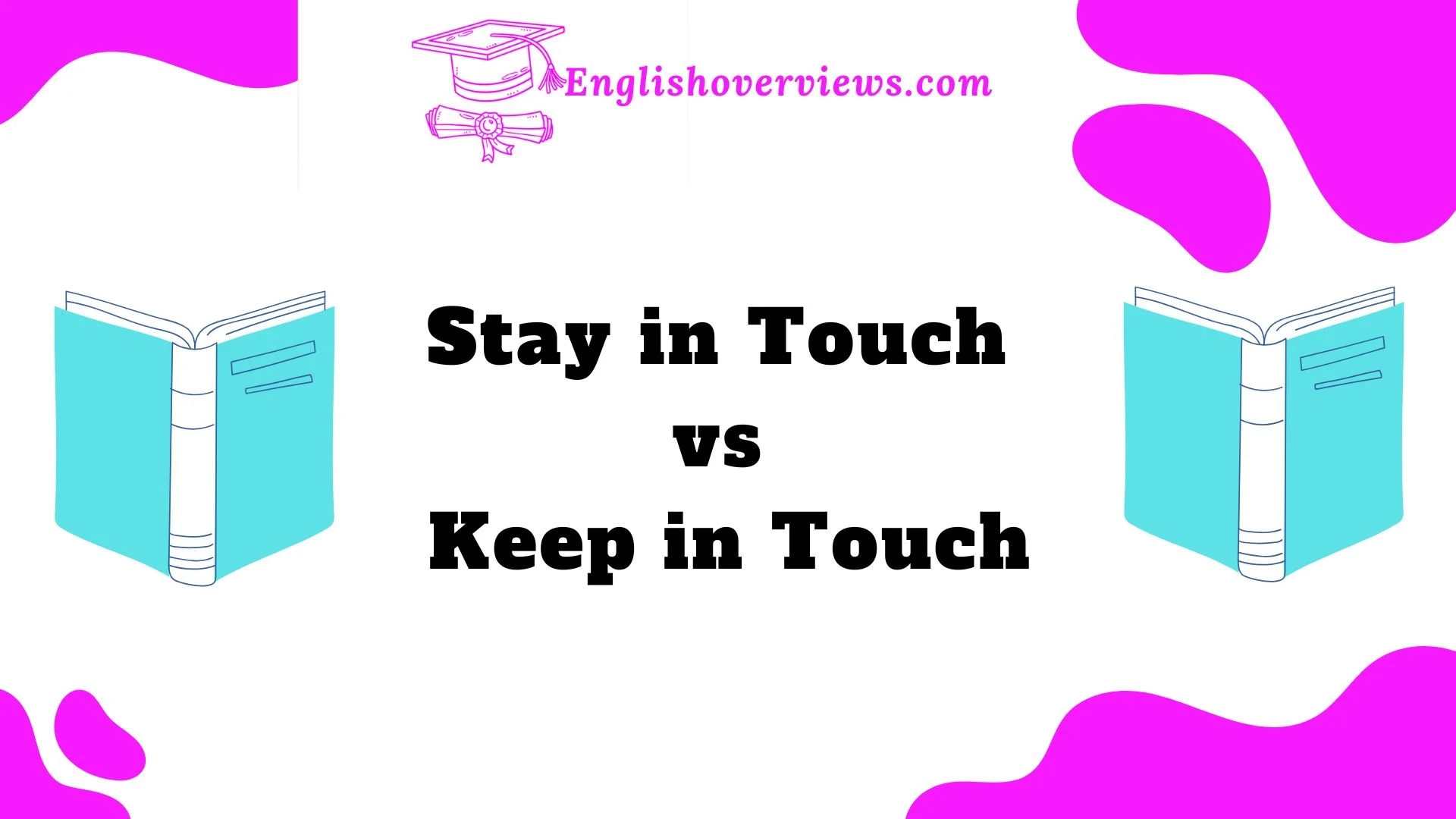In the world of communication, we use phrases like “stay in touch” vs “keep in touch” all the time without giving them much thought. They seem nearly identical, right? After all, both suggest a desire to maintain contact. But dig a little deeper, and you’ll find that there are subtle yet important differences between the two.
Understanding when and why to use each phrase can make a significant difference in how your message is received—whether you’re speaking with a colleague, a close friend, or someone you’ve just met.
In this blog post, we’ll explore the differences between “stay in touch” and “keep in touch” in detail. We’ll examine how tone, context, and culture influence the way we communicate and offer practical tips for choosing the right phrase in various situations.
By the end, you’ll understand how these two phrases can subtly change the dynamic of your conversations.
The Core Meaning of “Stay in Touch” vs. “Keep in Touch”
At their core, both “stay in touch” and “keep in touch” suggest the same thing: maintaining communication. However, the subtle differences lie in their connotations, the frequency of the contact they imply, and the contexts in which they’re used.
- Stay in Touch: This phrase often suggests a longer-term commitment to maintaining communication. It’s about continuing the relationship over time, with a focus on ongoing connection.
- Keep in Touch: This is more casual and typically implies periodic or occasional communication. It feels lighter, and less binding compared to “stay in touch.”
Examples
- Stay in Touch: “Let’s stay in touch after the conference to discuss future projects.”
- Keep in Touch: “It was great meeting you—let’s keep in touch!”
Summary
- Stay in touch signals an open-ended or ongoing commitment.
- Keep in touch conveys casual, occasional contact.
Shared Purpose: Building and Maintaining Connections
Both phrases serve the same overarching purpose: to maintain a connection with someone. However, how they are used can affect the perceived depth of that connection.
- Building connections: “Stay in touch” is often used when there’s a desire to deepen a relationship, while “keep in touch” can be a friendly, noncommittal way to say “let’s not lose touch.”
Example Case Study: Professional Networking
Imagine you’ve met a colleague at a networking event. If you’re looking to build a long-term professional relationship, you might say, “Let’s stay in touch about potential collaborations.” This sounds more intentional and focused on growth.
On the other hand, if you’re simply acknowledging the meeting and would like to check in from time to time, you might say, “It was great meeting you—let’s keep in touch.”
Deep Dive into “Stay in Touch”
When you say “stay in touch,” there’s often an underlying sense of intentionality. It conveys a stronger desire for a sustained connection.
- It suggests that you’ll be actively reaching out from time to time, with an expectation that the relationship will continue to grow.
- The phrase works well in both personal and professional settings when you’re serious about maintaining a long-term relationship.
Professional Context:
In the workplace, using “stay in touch” may indicate a deeper level of interest in keeping the relationship going after an event, project, or meeting.
Example:
“Thanks for your help on the presentation. Let’s stay in touch about the next steps for the project.”
Personal Context:
With friends or acquaintances, “stay in touch” could indicate that you’ll make an effort to check in regularly, whether that’s over the phone, via email, or in person.
Example:
“It’s been a while since we’ve caught up. Let’s stay in touch!”
Understanding “Keep in Touch”
On the other hand, “keep in touch” suggests light and casual communication. It implies a less active effort to maintain contact and often reflects a desire for occasional updates rather than regular ones.
- It’s typically used when you don’t feel the need for constant communication but still want to remain friendly and connected.
Example:
“Let’s keep in touch—would love to hear how things go with your new job!”
Professional Context:
In professional settings, “keep in touch” may be a way of saying, “I’m open to future contact, but no need to commit to regular communication.”
Example:
“It was great meeting you. Let’s keep in touch, and we’ll see what opportunities arise.”
Personal Context:
For personal relationships, “keep in touch” might suggest that while you don’t intend to have frequent contact, you’d still like to stay aware of what’s happening in the other person’s life.
Frequency, Sincerity, and Emotional Subtext
The choice between “stay in touch” and “keep in touch” can also depend on how frequently you want to communicate and the sincerity behind your message.
- “Stay in touch” can feel more sincere because it often implies a long-term commitment.
- “Keep in touch” can come across as more casual, but it doesn’t necessarily lack sincerity. It just indicates a more sporadic connection.
Professional vs. Personal Contexts
When to Use “Stay in Touch”:
- Business Partnerships: If you want to show commitment to a future collaboration or ongoing communication.
- Close Friends: When you want to show that you’ll stay engaged in their life despite distance or time.
When to Use “Keep in Touch”:
- Acquaintances: For maintaining light contact without any pressure for frequent communication.
- Professional Connections: When you’re open to casual follow-ups, but not expecting ongoing conversation.
Cultural and Linguistic Influences
Cultural differences can also affect how these phrases are interpreted.
- In Western Cultures (like the US or UK), both phrases are commonly used, but “stay in touch” might imply a stronger, more enduring connection.
- In Middle Eastern or Asian Cultures, where relationships tend to be built on long-term commitment, “stay in touch” might be used more frequently to signify an enduring bond.
Example:
In the UAE, “stay in touch” may be more commonly used in both business and personal contexts to convey the importance of continuing communication.
Choosing the Right Phrase for the Right Moment
Practical Guide:
When you’re unsure of which phrase to use, consider the following:
- Relationship Type: Use “stay in touch” for closer, long-term relationships, and “keep in touch” for acquaintances or casual connections.
- Communication Frequency: If you expect to reach out or be contacted regularly, say “stay in touch.” If the communication will be occasional, opt for “keep in touch.”
- Tone and Intent: If your intention is to show a commitment to nurture the relationship, “stay in touch” is your go-to. For more flexible or casual interactions, “keep in touch” works better.
The Impact of Tone, Intent, and Communication Goals
Your tone can drastically change the meaning behind your words. When deciding between “stay in touch” and “keep in touch,” ask yourself:
- What is my intent?
- Am I signaling a serious commitment to communication, or just expressing politeness?
In many cases, tone can also soften the meaning of “keep in touch,” making it sound more like an open invitation than a requirement.
Conclusion:
In conclusion, while “stay in touch” and “keep in touch” both focus on maintaining relationships, the choice of words reflects subtle differences in commitment, tone, and intent. Understanding these nuances helps you communicate more effectively in both personal and professional contexts.
By choosing the right phrase, you can nurture connections with greater clarity and intent, ensuring that your communication aligns with your desired relationship dynamics.
FAQs:
Q1: Are “stay in touch” and “keep in touch” interchangeable?
While they can sometimes be used interchangeably, “stay in touch” often implies a more ongoing, intentional effort to maintain communication, while “keep in touch” can suggest casual, occasional contact.
Q2: Which phrase is more formal?
“Stay in touch” is generally more formal, as it indicates a stronger commitment to continuing the relationship.
Q3: Can I use “keep in touch” in professional emails?
Yes, “keep in touch” is perfectly acceptable in professional contexts, especially when suggesting occasional follow-ups.

English Overviews is a resourceful website dedicated to providing valuable content related to grammar and vocabulary. AD has made notable contributions, sharing insights on various subjects, including WordPress themes and plugins. The primary goal of the site is to help users improve their English language skills effectively.











